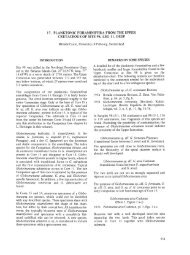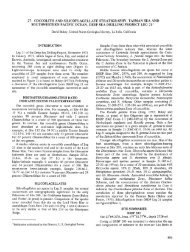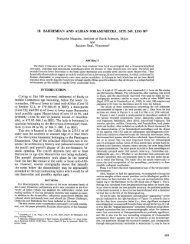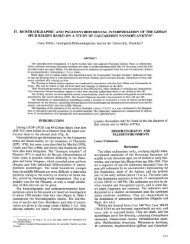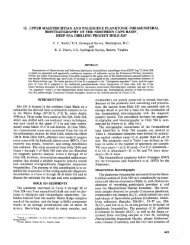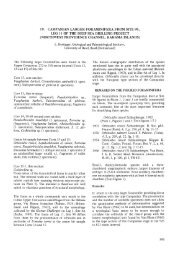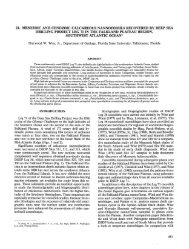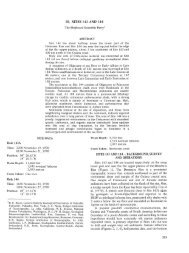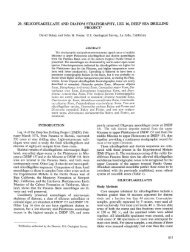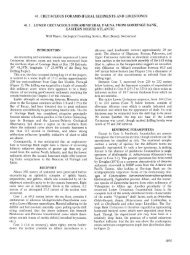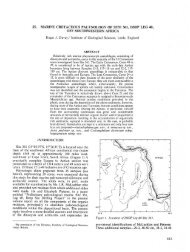16. Radiolaria - Deep Sea Drilling Project
16. Radiolaria - Deep Sea Drilling Project
16. Radiolaria - Deep Sea Drilling Project
You also want an ePaper? Increase the reach of your titles
YUMPU automatically turns print PDFs into web optimized ePapers that Google loves.
M. G. PETRUSHEVSKAYA, G. E. KOZLOVA<br />
Carpocanistrum sp. O<br />
(Plate 22, Figures 28, 30)<br />
Carpocanistrum sp. Riedel and Sanfilippo, in press, pi. 2F, figs. 5-7,<br />
part.<br />
Test about 70-90µ long and 65-75µ broad. About eight to nine<br />
longitudinal rows or pores on the half equator of the thorax. About<br />
seven or eight pores in one row. Mouth as a short tube.<br />
Oligocene-Miocene.<br />
Carpocanistrum sp. aff. C. pulchrum<br />
(Plate 22, Figures 19, 20)<br />
Carpocanistrum sp. Riedel and Sanfilippo, in press, pi. 3D, figs, 3, 5,<br />
part.<br />
^Carpocanium pulchrum Carnevale, 1908, p. 30, pi. 4, fig. 15.<br />
Test about 70-100µ long and 70-90µ broad. About six to eight<br />
longitudinal rows of pores on the half equator of the thorax. About<br />
six pores in one row. Rows are separated by longitudinal ridges.<br />
Mouth as a short tube.<br />
Upper Oligocene-Miocene.<br />
Carpocanistrum cristatum Carnevale<br />
Sethocorys cristata Carnevale, 1908, p. 31, pi. 4, fig. 18.<br />
Carpocanopsis cristatum (Carnevale) Riedel and Sanfilippo, in press,<br />
pi. 1G, fig. 16, pi. 2G, figs. 1, 2, part.<br />
The description as in Riedel and Sanfilippo. But only about nine<br />
or ten pores on the half equator of the thorax. Cephalis plus thorax<br />
are about 75-80µ long.<br />
Miocene.<br />
Genus CARPOCANIUM Ehrenberg sens. str.<br />
Carpocanium Ehrenberg, 1847b, p. 54; Haeckel 1887, 1279;<br />
Campbell, 1954, pi. 127; Petrushevskaya, 1971b, p. 239, part. =<br />
Carpocanidium Haeckel, 1887, p. 1280; Campbell, 1954, p. 127.<br />
Type species Lithocampe solitaria Ehrenberg 1844 (1854, pi. 22,<br />
fig. 28).<br />
Cyrtocalpis Haeckel, 1860, p. 835; 1887, p. 1185; Campbell, 1954,<br />
p. 121. Type species Cyrtocalpis amphora Haeckel (1862, pi. 5,<br />
fig. 2).<br />
Very much the same as Carpocanistrum, but the thoracic wall is<br />
thinner. The thorax is ovate, nearly cylindrical.<br />
Carpocanium sp. aff. C. coronatum Ehrenberg<br />
(Plate 22, Figures 25, 26)<br />
" Carpocanium coronatum Ehrenberg, 1858, p. 30; 1875, pi. 5,<br />
fig. 7.<br />
1 Carpocanistrum sp. Riedel and Sanfilippo, in press, pi. 3D, fig. 8,<br />
part.<br />
Test about 70-80µ long and 60-70µ broad. About eleven<br />
longitudinal rows of the pores on the half equator of the thorax.<br />
About nine to ten pores in a row. Mouth as a short tube.<br />
Oligocene.<br />
Genus CARPOCANOBIUM Haeckel<br />
Carpocanobium Haeckel, 1887, p. 1282; Campbell, 1854, p. 127.<br />
Type species Carpocanium trepanium Haeckel, 1887, pi. 52,<br />
fig. 18.<br />
Asecta Popofsky, 1903, p. 373; Campbell, 1954, p. 128. Type<br />
species Asecta prunoides Popofsky, 1913, text-fig. 89.<br />
The thoracic wall is thin. The thorax is broader in its distal part<br />
than near the cephalis.<br />
Carpocanobium sp. aff. C. setosa (Ehrenberg)<br />
(Plate 22, Figures 27, 28)<br />
IHalicalyptra setosa Ehrenberg, 1875, pi. 2, fig. 12.<br />
Carpocanium hexagonale Haeckel, 1887, p. 1282, pi. 52, fig. 15.<br />
Carpocanistrum sp Riedel and Sanfilippo, in press, pi. 3D, figs. 7, 9.<br />
Test about 80-100µ long and up to 70-85µ broad. Longitudinal<br />
rows or pores are uncertain. There are about twelve pores on the<br />
half equator of the thorax, and about eight or nine pores on the<br />
length of the thorax. Mouth as a broad tube (very short).<br />
Oligocene.<br />
536<br />
Subfamily Group C<br />
Includes Carpocaniidae with pores arranged irregularly or in<br />
checker-board order. Abdomen is rather large. Pores on the<br />
abdomen are similar to those on the thorax.<br />
This group was described by P. Dumitrica (1970, p. 53-54) as<br />
"Cryprocephalic tricyrtid group". But here this group is accepted in<br />
a narrower sense than was suggested by P. Dumitrica. The species<br />
which are distinguished by longitudinal arrangement of pores<br />
{Diacanthocapsa comys, Diacanthocapsa sp. Dumitrica 1970, pi. 20,<br />
figs. 129-130) are included in the present paper as real Carpocaniidae.<br />
As can be seen on Figure 43, Plate 7 in Dumitrica's report,<br />
the species mentioned above not only have a spherical eucephalic<br />
part (chamber) of the cephalis, but also the surrounding parts<br />
(lobes) of the cephalis. One of these parts, the lateral lobe, is even<br />
figured by P. Dumitrica on Figure 43. It is the same lobe as figured<br />
by M. Petrushevskaya (1968d, fig. 9). All these Carpocaniids are not<br />
included in the cryptocephalic group in question. By the way, the<br />
eucephalic chamber in this latter group is not so deeply hidden in<br />
the skeleton as is typical for real Carpocaniinae, and the subfamily<br />
group in question is very similar to many Eucyrtidiidae {Lithocampe,<br />
Theocotyle).<br />
Genus DIACANTHOCAPSA Squinabol<br />
Diacanthocapsa Squinabol, 1903, p. 133; Campbell, 1954, p. 129;<br />
Dumitrica, 1970, p. 61. Type species Diacanthocapsa euganea<br />
Squinabol (1903, pi. 8, fig. 26).<br />
Diacanthocapsa sp. A group<br />
(Plate 7, Figure 11; Plate 22, Figures 4, 6)<br />
ITheocapsa (Theocapsomma) amphora Campbell and Clark, 1944b,<br />
p. 35, pi. 7, figs. 30,31.<br />
?Theocapsomma amphora (Campbell and Clark) Foreman, 1968, p.<br />
31, pi. 4, figs. 9a-c.<br />
Our Cretaceous specimens (Plate 7, Figure 11) differ from the<br />
Tertiary specimens in the outline of the abdomen (Plate 22, Figures<br />
4,6).<br />
Cretaceous-Tertiary.<br />
Diacanthocapsa sp. B<br />
(Plate 7, Figures 4, 5)<br />
Theocapsomma sp. Riedel and Sanfilippo, 1970, pi. 3, fig. 1.<br />
Differs from Diacanthocapsa sp. A group by its more pronounced<br />
cephalis.<br />
Cretaceous (Maestrichtian).<br />
Family ARTOSTROBIIDAE Riedel<br />
Artostrobiidae Riedel, 1967a, p. 149; 1967b, p. 296; Petrushevskaya,<br />
1971a, p. 985; 1971b, p.235.<br />
Cephalis originally widely open to the thorax. It consists of a<br />
eucephalic lobe and antecephalic lobe. The latter has only a<br />
"dorsal" (sens. H. Foreman, 1968) part, without the apical-dorsal.<br />
As a rule, there is a distinct tube connected with the spine Vert—see<br />
Petrushevskaya, 1968b, fig. 6.<br />
Subfamily Group A<br />
Includes three-segmented genera having the pores disposed<br />
irregularly or in distinct longitudinal rows.<br />
Genus RHOPALOSYRINGIUM Campbell and Clark,<br />
emend. Foremen<br />
Rhopalosyringium Campbell and Clark, 1944b, p. 30; Campbell,<br />
1954, p. 130; Foreman, 1968, p. 54. Type species Rhopalosyringium<br />
magnificum Campbell and Clark (1944b, pi. 7, figs. 16,<br />
17).<br />
Rhopalosyringium sp. aff. R. magnificum<br />
(Plate 7, Figures 14-17)<br />
1Rhopalosyringium magnificum Campbell and Clark, 1944b, p. 30,<br />
pi. 7, figs. 16, 17; Foreman, 1968, p. 55, pi. 6, figs. 7, a, b.<br />
ITheoperid gen. sp. indet. Riedel and Sanfilippo, 1970, pi. 3, fig. 4.<br />
Cretaceous (Campanian-Maestrichtian).



